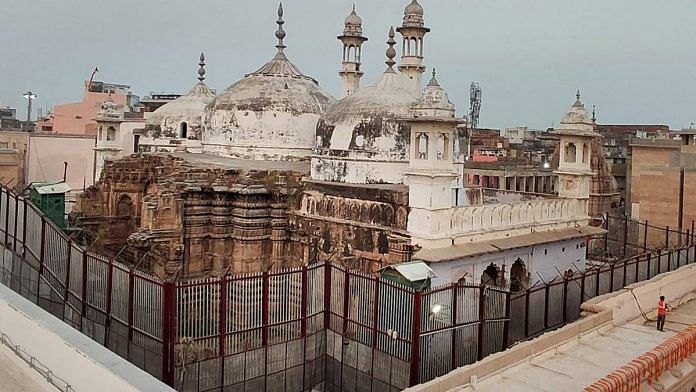New Delhi: The Allahabad High Court in an order passed earlier this week said it cannot determine whether the Gyanvapi complex in Varanasi is a temple or mosque, unless the Varanasi civil court decides on its religious character (as it existed on August 15, 1947) — a matter that Muslim petitioners in the case claim has already been settled in a 1937 decision of the civil court.
The petitioners have claimed that the decision in the 1937 case of Din Mohammed vs Secretary of State had settled that Muslims were entitled to the land and a mosque existed at the site of dispute, and that the matter was res judicata (question of law that has been finally decided and cannot be re-raised).
In the 1937 case, a civil court had held that land on which the mosque stood and its plinth was Hanafi Muslim waqf land and belonged to the Muslims.
Waqf refers to inalienable charitable endowment under Islamic law.
The Muslim petitioners had argued in the 1937 case that the entire complex (mosque and enclosure) was “waqf” property, and even if it was not waqf, they had acquired a right by custom to pray in the area.
In the present case in the Allahabad High Court, it was claimed that Hanafi Muslims were entitled to offer prayers and perform other religious acts in the Gyanvapi complex.
The civil judge had held in 1937 that the land under the mosque and its plinth was a charitable endowment and had also agreed with the Muslims’ contention that they had been in the habit of praying at the mosque, allowing partial relief.
However, the petitioners were not satisfied and had appealed in the high court subsequently, which dismissed the plea in 1942, holding that it could not be said that the entire complex land was “waqf”.
ThePrint recalls the 1937 decision and the appeal which, while dismissed by the Allahabad High Court, had discussed the matter in great depth.
Also Read: Allahabad HC expresses ‘strong doubts’ about method, stays ASI survey in Gyanvapi Mosque
Civil court & HC’s view
The 1937 case was filed in the civil court by three Sunni Muslims against the Secretary of State, claiming their right to use the entire enclosure of the complex in Varanasi for their religious ceremonies.
The plea arose when the district magistrate in 1937 refused permission to congregate outside the upper platform of the mosque or pray within the Gyanvapi complex.
The Muslim petitioners’ main argument was that they were entitled to use the paved portions outside the mosque on the last Friday of the Muslim holy month of Ramzan if the congregation was too large to be accommodated in the mosque itself.
The civil judge held that the land under the mosque to indeed be a charitable endowment (waqf) and also agreed with the petitioners’ contention that they had been in the habit of praying at the mosque.
He said Muslims could use the property for their ceremonies, and the land near the graves could be used once a year. However, the judge said they had no right to offer ordinary daily prayer in the area marked “red” — denoting the area between the mosque and the surrounding houses. The court only allowed prayers in designated areas.
The plaintiffs were not satisfied with the decision and appealed to the Allahabad High Court.
The high court said that it was not necessary to go into the history of the mosque at all. It noted an 1810 letter written by the Magistrate of Benaras that Muslims be excluded from the complex (around the mosque), which was rejected by the Vice-President.
It also noted that there was a constant strife between two religions and noted various orders from that period with conflicting notions of who the rightful owner of the disputed property was.
“Then from the year 1854 there are a series of orders, by various courts and officials, which show that Hindus and Musalmans were making attempts to encroach upon each other’s rights,” the high court had then said.
The appellants said that once the land was declared to be waqf, nothing could change or amend its character, and also relied on the khasra register to prove that the land comprised a mosque with an enclosure.
The court noted that it could not be assumed that the whole enclosure (and not just the mosque) was dedicated (to the community).
The high court noted that the “only evidence” available was oral evidence of about 18 witnesses and agreed with the civil court judge that it could not be said that the entire property was waqf property. In turn, the contention that the additional enclosure was waqf property was dismissed by the high court.
Regarding the contention on customary rights, the court said that to acquire such a right, there must be evidence to show that the existence of the right had been recognised and that it had become part of the law itself.
“A custom which amounts to law is one which has obtained general recognition by those concerned, or, in other words, a customary rule becomes law when it is generally recognised that the rule should be applied to certain sets of circumstances,” the high court said.
It opined that this was an unnecessary question in the present case and noted that the excess inflow in the mosque may have been the product of an intention to create such a customary right, which did not exist.
(Edited by Nida Fatima Siddiqui)
Also Read: ‘Necessary for justice’ — Allahabad HC rejects Gyanvapi mosque committee’s appeal against ASI survey



